Murder: “Acting for the general welfare”
This post is a part of our series on Tom Horn – full collection of links at the bottom of the page.
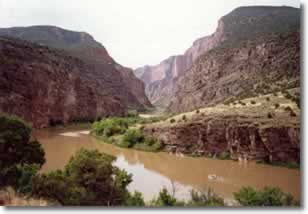
the locale of two murders attributed to Tom Horn (author’s photo)
An ominous killing in the northwestern Colorado Brown’s Hole region struck the area in mid-1900. Even more sinister was the plot that lay behind it.
Two small cattlemen, Matt Rash and Isam Dart, had been in Brown’s Hole in northwestern Colorado for a number of years. In July and October 1900 both were killed. Their previous actions, along with those of other small ranchers, had led to conflict and a conspiracy on the part of three prominent ranchers to eliminate them. Tom Horn was their agent.
The prologue of their murders was the developing cattle business as the new century began.
By the mid-1890s the cattle business in Wyoming and Colorado was changing in major ways, in large part because consumer tastes had started to gravitate toward more tender and flavorful beef from breeds other than longhorns. And while longhorns are hardy and calve easily, they do not add weight as rapidly as other breeds.
Another major reason for the changes in the range business was an influx of homesteaders. The homesteaders, “nesters” or “grangers” as they were referred to disdainfully by the big operators, had moved over a period of time into some of the best bottomlands. By doing so they decreased the availability of water for the herds of the dominant, larger ranchers, or “cattle barons,” as they became known.
One major operator was Laramie’s Ora Haley, who had enormous holdings both in northwest Colorado and southeast Wyoming and who acted to adjust to the changing conditions.
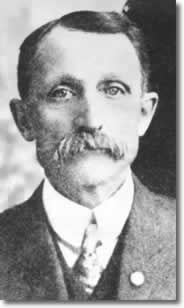
Haley, who was born in Maine in 1845, had come to Wyoming at a young age, and become a force in the Wyoming cattle business and in territorial politics. Through his foreman, Hiram “Hi” Bernard, he brought in white-faced Herefords to improve the grades of beef that markets now demanded.
Bernard, a Texan who had driven cows to northern reaches as a young man, observed that as cattle operations evolved, overheads increased. It became necessary to purchase or lease land from the railroads, to fence bull pastures in order to produce summer calves of uniform weight, and raise hay to feed stock. Bernard purchased several large hay ranches for Haley in Colorado’s Routt County area, which comprised Brown’s Hole. It was enormously profitable in spite of the depredations of locals. Bernard described the range and Haley’s success. He commented,
These ranches extended over a wide scope of the county, with both winter and summer ranges on all sides. It was open public domain, all choice range, and with few fences to hinder the movement of cattle for a distance of about 100 miles in all directions. That constituted a pretty layout, and easy to handle.
It proved to be good. Haley made over a million dollars profit on his Routt County investment in less than ten years. And in that time he never saw the range end of the business but three times. He did not know a thing about it for he was not a range man.
Haley was a smart and lucky financier. He came to Wyoming a bullwhacker, and started in the cow business at Laramie with three old dairy cows. He was smart enough to see opportunities and capitalize on them, lucky to find a sucker to handle a range cattle business better than he could, and he was wise enough to keep from meddling with the range end, where the payoff came from. That is a rare combination of human character.
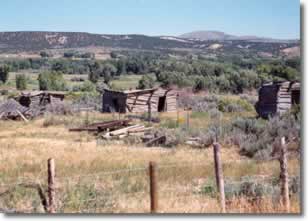
Conditions, however, were such that a range war was brewing in northwestern Colorado, just as one had raged in Wyoming.
But there was a difference in the situations between Wyoming and Colorado. In Wyoming, it was the cattlemen who had attempted to keep homesteaders and small ranchers from infringing on lands they felt were exclusively theirs. The Brown’s Hole locals, many of them homesteaders and small ranchers, instead resisted encroachment on their ranges by the cattle barons.
For a time, the Wyoming cattlemen were successful in holding off what they felt was wrongful encroachment of “their” lands. However, the winds of change were against them, and their strong-arm tactics had begun to go too far.
They had had gone as far as to resort to outright murder, lynching “Cattle Kate” Ellen Watson and Jim Averill in south-central Sweetwater County in 1889, and Tom Waggoner in northeast Weston County in 1891. The Johnson County Invasion followed in 1892 with the accompanying murders of Nick Rae and Nate Champion. Over time, however, the homesteaders and small ranchers were bound to prevail, simply because of their sheer numbers.
In northwest Colorado the small ranchers misjudged the changes that would occur in their own region, just as had the barons in Wyoming. In northwest Colorado, the big ranchers, whose holdings included both Wyoming and Colorado lands, were determined to move into the ranges not being put to use. Vacant, valuable land sat unused when they needed it.
The first mistake the Brown’s Hole locals made was failing to acquire ranches that were readily available along their eastern perimeter. Had they done so, they could have resisted further inroads by the large operators. The ranches were owned by Ben Majors and one Sainsbury, and were acquired in 1894 by Ora Haley.
The second mistake was allowing the area to become known as a “safe haven” for outlaws. Bernard remarked that “the reported presence of such characters helped to scare outside stockmen away from the gravy bowl. It was a ‘no trespassing’ sign, and it worked for a long time.” However, their sympathy for and assistance to outlaws inevitably created animosity toward them.
Bernard added that the nesters’ third mistake was “they were range hogs, for they were controlling a greater amount of range than they used or could use. ‘It must be kept that way’ – one of Brown’s Park’s ‘musts.’ Well, time changes things, and it ‘must’ be a hell of a shock to some of them to see things now,” he said. Long-term, the range would not remain open and the big outfits would move in.
Bernard’s further observations brought proof of Tom Horn’s complicity in the murders that were to come.
Late in 1899 or early in 1900, Ora Haley ordered Bernard to meet him at Haley’s Denver office. At the time Haley was fifty-five and married with grown four children living in Laramie. Three other cattlemen were present: Charles E. “Charley” Ayer, Wilfred W. “Wiff” Wilson, and John C. Coble.
Ayer, forty-three, was born in New York, married with five children and lived in the Four Mile area of Routt County, Colorado.
Wilson was born in Utah in 1857 and was living with his wife, three children and mother-in-law near Baggs in southern Carbon County, Wyoming. Both Ayer and Wilson had significant livestock holdings in southern Wyoming and Brown’s Hole.
John C. Coble was born in 1857 in Pennsylvania and was a partner of Frank Bosler in the prominent Iron Mountain Ranch Company of Bosler, Wyoming, north of Laramie. Tom Horn was on Coble’s payroll at the time.
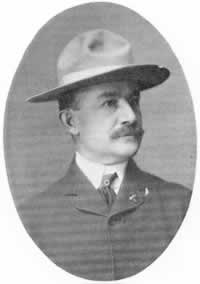
By January 1900 Tom Horn had wrapped up his investigation of the Wilcox, Wyoming train robbery of the previous June.
At the Denver meeting in Haley’s office Ayer and Wilson bewailed the lawlessness that infested Brown’s Hole, condemning “the place as an outlaw hangout and a threat to the Haley interests,” Bernard said. Both recounted their cattle losses and named Matt Rash and Jim McKnight as rustlers.
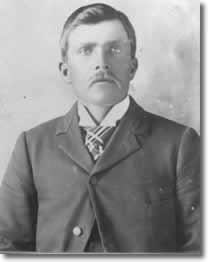
Coble had like grievances in his part of the country, and he offered a solution to the problem that would wipe out the range menace permanently. He would contact a man whom he knew with the Pinkerton Detective Agency, a man that could be relied on to do the job, with no questions asked.
Tom Horn was the man chosen by Coble.
Coble continued that Horn was to be paid five hundred dollars for every known cattle thief
he killed….
This essay was originally published on Chip Carlson’s personal website, which has since expired, and is re-published here as a way to preserve some of the content of this historical figure. If you would like to continue learning about Tom Horn, please explore the links below. If you’d like to read the complete story, and help to support the author, his book can be purchased here.
More about Tom Horn:
Tom Horn (main page)
The Tom Horn Story (summary)
